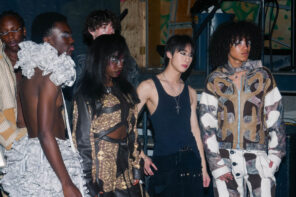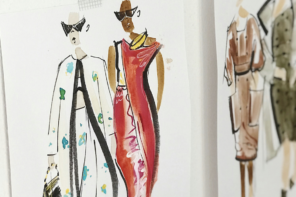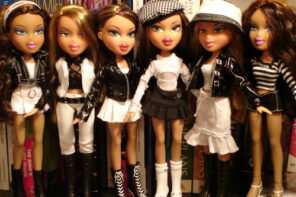In 1991, the Soviet Union flag was officially taken down from the Kremlin. After living decades in impoverished conditions, Eastern Europeans cheered for their freedom. They happily accepted the newly available Western films, clothing, food, and music, with hope for a better future. However, years later it seems their communist past isn’t so easily escapable. Many influences from the Soviet years remain, against the will of many of the regime’s survivors, and these have bled into Western culture through hyper-generalized stereotypes of inferior manners and poor taste. It is now 2018, and while Eastern Europeans continue to be identified with plumbing, alcoholism, and job-theft, Westerners have commodified the poverty-stricken, post-Soviet lifestyle in fashion.
Anyone relatively interested in the industry has noticed the recent fame of oversized rag-looking clothing, poor tailoring, oddly shaped tracksuits, and Cyrillic lettering – all largely inspired by the post-Soviet culture of the 1990’s. While wearing cheap, 90s sportswear and tucking trousers into socks was not typically considered stylish, the mannerless, former-USSR style has prompted a fashion revolution.
Being from Poland myself, I find the obsession with poor Slovak fashion unbalanced. From my own position of privilege, I grew up looking down at Adidas tracksuits, consumerist logos, and slip-on slides, because they were worn by a lower class characterized as unfriendly, mannerless, and aggressive. It is exciting that the fashion world has incorporated new styles and trends from a long-neglected, under-represented culture. But they are now being bluntly presented across luxe designer collections, with little understanding of the context – a jarring reality of crime, poverty, and social alienation.
At the end of the day, exploiting poverty and violence is not stylish
Has the fashion industry really recycled every other potent idea that it now offers ‘cheap’ clothing at premium pricing? Or is this just another attempt by privileged and uninformed Westerners fetishizing impoverishment – knowing that they can easily escape from it when it’s no longer ‘in style’?
It’s cool to dress like you’re poor, as long as you can afford it. To actually experience the utilitarian, hopeless environment of post-Soviet Eastern Europe – as my parents did while waiting in line for hours to get eggs or bread, or walking past military tanks under martial law on the way to school – and then move to the West, where it is exploited with zero understanding of its context, is demeaning. To look like a gopnik or dres (Eastern European versions of ‘white trash’ or British ‘chavs,’ also known as lower-class males that roam alleyways to drink, fight, and swear) doesn’t just prove trendiness. It presents a history of Eastern Europe’s scarcity, brutality, and lack of opportunity. At the end of the day, exploiting poverty and violence is not stylish.
It is especially condescending to see Westerners embrace my culture’s fashion sense while simultaneously feeling threatened by my people. People here can dress like a poor Slovak without having the image’s negative stigma follow them around. If I were to wear an ‘underground’ outfit from the former Eastern bloc, I would immediately be associated with manual labour and job theft. We live in a world where Poles are smelly construction workers, Ukrainians are cleaning ladies, Romanians are pocket-pickers and beggars, and Russians are secretly involved with the mafia. While conditions have somewhat improved from Soviet rule, Eastern Europeans still face prejudice and discrimination.
People here can dress like a poor Slovak without having the image’s negative stigma follow them around
I also cringe when millennials consider post-Soviet fashion as ‘hypebeast.’ While many such collections are largely inspired by street and skatewear worn by the poor youth of small Eastern European towns, they are backed by authenticity – unlike designers like Supreme whose clothing lacks any cultural understanding. For large retailers such as H&M and Zara to take advantage of the trend for profit, and create pieces resembling those knitted by Soviet designers, takes money, opportunity, and space away from artists with genuine Soviet experience. Gosha Rubchinskiy, Demna Gvasalia (of Vetements), MISBHV, or Sputnik 1985 are only a few who have fought for years to gain an audience in the industry. They are the ones whose culture is being represented in this style; they are the ones who began this revolution; they should lead its development in fashion.
These designers pay tribute to the culture without romanticizing it. Their garments translate the impecunious, chaotic environment in which they grew up in. For instance, Gosha’s newest FW18 collection that premiered at the Yeltsin Presidential Center in Yekaterinburg perfectly captured the ethos of the poverty-stricken conditions of Eastern Europe post-USSR. The show was more than just a preview of military-inspired, utilitarian garments and nostalgia-driven sportswear; it placed attendees in a genuine, post-Soviet environment. Not only did it take place in a historic building enrapturing Russia’s former president Yeltsin’s life, but the catwalk was staged in a chaotic, almost violent manner. It featured a live band that played aggressive tunes resembling gunshots and rebellion. Unfit models didn’t just strut down the catwalk with their heads shaved – they rushed abnormally quickly in a disorganized manner, as if there was a surplus of gopniks and no backstage changing room.
For many Eastern Europeans, these designers’ rise to fame is empowering, and opens a discussion about the culture’s authentic representation in the West. They are local heroes, who show a new, unconventional type of beauty to the rest of the world – a testament to strength and resilience in the face of brutal economic recessions and corrupted regimes. Dressing in the former-Eastern bloc style is about more than just physical aesthetics, a trend spanning fashion weeks, or big-name designers. To dress like a Slav is to understand the history, the hardship, and the suffering, and to rebel against the culture’s misrepresentation.








